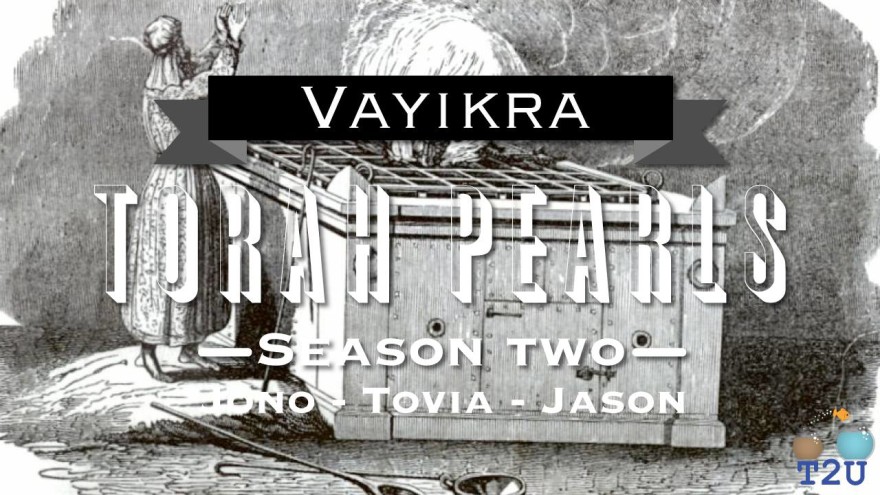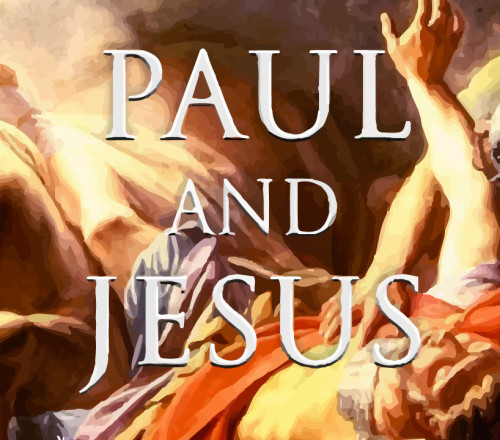Torah Pearls – Season 2 – Vayikra – Rabbi Tovia Singer, Jono & Jason
Are all sacrifices “sin sacrifices”? Is there a male lamb sin sacrifice that takes away the sin of the world? Plus, St. Patrick’s Day, Israeli election results, what hospitalized Jason last week, and much more in this week’s Torah Pearls!
Join us for this year’s Tanakh Tour of Israel!
[karma_by_kadar__simple_player title=”Truth2U” src=”https://truth2u.org/wp-content/uploads/Audio/Truth2U%20-%20Torah%20Pearls%20-%20Season%202%20-%20Vayikra.mp3″ volume=”0.9″ autoplay=”true” downloadable=”true” color=”1″]
[wp-post-slider]





You three always sound like you are having fun, but this week? Wow. Rabbi Tovia Singer doing a Jono impersonation complete with an Australian accent? Priceless!
Tovia, I stopped listening because of your banter. This is not comedy hour. If you are the smartest person in the room, it will be apparent. Jono, this is not the projection you need.
James
On Yom Kippurim, is the high priest doing atonement on behalf of? Lev. 16:30 & 33 is that what a mediator does? Explain the difference.
Hi Jacinte. To understand sacrifices start with the realization that there are both communal and individual qorban (sacrifices).
For individual sins the “sin” sacrifice (חַטָּאת / chatat) is an atonement, but a very specific TYPE of atonement. It was brought for personal cheits — an unintentional sin through carelessness — a “missing of the mark.” There were also communal חַטָּאת / chatat (sin sacrifices). חַטָּאת / chatat could not be brought for intentional, willful sins.
The only other types of individual sins which could be atoned for with a sacrifices was the אָשָׁם / asham (translated as guilt or tresspass sacrifice) which was for three different types of violations:
1. unintentionally taking and using something from the holy Temple. The person must return the items, add 1/5th in restitution and bring an asham;
2. asham taluy is for when you aren’t sure if you sinned or not, so just to be sure you bring an asham taluy. If later you discover that you did commit a cheit (accidental sin) you bring a chatat (sin offer);
3. asham g’zelot if you lied under oath defrauding someone of his things or money. In this case again you have to return the stolen things and add 1/5th to it as well as bring the asham g’zelot.
Those were for individuals who had commited one of the sins covered by the חַטָּאת / chatat or the אָשָׁם / asham.
Now on to communal sins. The Temple is community property. People come and go constantly. Before they enter the Temple they are suppose to bathe in a mikvah (ritual bath) which cleanses them ritually. Of all the thousands of people who entered the Temple what if there were a handful who entered without bathing in the mikvah? It means the Temple is ritually impure.
Ergo a sacrifice is brought on Yom Kippur “just in case.” This sacrifice is brought on behalf of the entire Jewish nation. Rather than being a “mediator” think of the kohein gadol (high priest) as being the people’s representative. After all many people, but only one sacrifice for “all” the people.
The communal Yom Kippur (“Atonement Day”) ceremonies are detailed in chapter 16 of Vayikra (Leviticus), where AN OX was offered for the kohein gadol (high priest) and all the other priests (verses 3, 6, 11) and two GOATS were offered for the nation (verses 5, 7-10, 15). The identical goat which was not sacrificed was sent away into the desert to עֲזָאזֵל, (Azazel) and NOT killed. The goat for עֲזָאזֵל (Azazel) was the one who symbolically “carried away” the nation’s sins.
The priest’s bull is to cleanse the inner part of the Temple from ritual impurities that priests may have made during the year. Remember that chatat (sin offers) are for mistakes, a “missing of the mark” — accidental sins. The bull in question is for Aaron (the high priest himself). So ask yourself: if two goats (one killed and one not) atoned for the sins of all Israel why the bull? Why the ram? Why the other requirements?
One of the two identical goats is sacrificed to cleanse the inner part of the Temple from ritual impurities that common Jews might have made during the year.
It isn’t just about the sacrifces either. What other requirements? READ the chapter!
The kohein gadol must put on a sanctified white linen tunic, and have linen pants on his body. He must [also] gird himself with a linen sash, and bind his [head] with a linen turban. These are sacred vestments, and [therefore], before putting them on, he must immerse in a mikvah.
The high priest must have on very specific clothes. Without these vestments the sacrifice is not acceptable. Get that? The blood sacrifice is UNACCEPTABLE if the priest does not wear the right clothes!
Now lest you think this is exaggerating — go back and read the first line of chapter 16. It speaks of the death of Aaron’s sons. They died because they brought an unauthorized fire (sacrifice) to G-d.
He shall [begin by] presenting his own sin offering bull and atoning for himself and his family (16:6)
The high priest (in this case Aaron, Moses’ brother) atones for his sins and for his family — again accidental sins.
Now read lines 15 and 16 which are about the bull Aaron sacrifices for himself and the goat which he sacrifices for the Israelites — it is not that this goat atones for the sins of the Israelites in general (lumped with the goat for Azazel) — but it has to do with ritual purity and accidental defilement of the Temple, as the bull did for Aaron himself. READ the text!
He shall then slaughter the people’s sin offering goat, and bring its blood into [the inner sanctuary] beyond the cloth partition. He shall do the same with this blood as he did with the bull’s blood, sprinkling it both above the ark cover and directly toward the ark cover. 16 Thus shall he provide atonement upon the Sanctuary for the contaminations of the Children of Israel. . .
Defilement refers to Israelites entering the sanctuary or eating sacrifice while unclean (Rashi; see Vayikra / Leviticus 15:31)
You [Moses and Aaron] must warn the Israelites about their impurity, so that their impurity not cause them to die if they defile the tabernacle that I have placed among them. (Vayikra / Leviticus 15:31)
The second goat (the scapegoat) is sent to Azazel in the wilderness (alive) — well until it falls off of a cliff!
This whole fixation on blood, blood, blood by missionaries is not supported by the Jewish bible. The missionaries take the statement that blood can atone for SOME sins and somehow morph it into “you need blood for sins to be forgiven.” This is akin to eating a slice of pizza because you are hungry and then insisting that the only type of food that exists in the world is pizza. How crazy is that?
This mistake that atonement of sin requires a blood sacrifice comes from Hebrews in the Christian bible where they distort Leviticus 17:11 where Jews are forbidden from EATING blood and told its only purpose is on the altar or to be thrown away into the dirt (Leviticus 17:13).
The Christian bible (Hebrews) turns this around as if only blood atones, when all Torah says is “don’t eat blood — the only use for it is in sacrifices. If you can’t sacrifice, throw it in the dirt.”
So the Christian bible says you need blood and there is no atonement without blood — but Torah and G-d disagrees.
The fact is that during Temple times, sacrifices were not required for all sins, only for a “missing of the mark” (mistake) or for very specific, generally minor sins which are all specified in the Torah.
There have always been many methods of atonement including prayer. Prayer is not a “replacement” or “substitution”.
For those sins that required sacrifices, the fact is that WITHOUT prayer, charity, fasting, etc.., there was no atonement – due to lack of obedience.
Even in bringing a sacrifice there were many things that added up in the atonement process. Sacrifice without obedience was useless. Obedience without sacrifice when sacrifice was required and possible, was useless. Obedience without sacrifice when sacrifice was never required or when sacrifice wasn’t possible – was and is sufficient in and of itself, since it’s all that G-d requires when sacrifices cannot be offered (see Hosea 14:2-3, Ezekiel 18/33).
Quote: 1Kings 8-33 “When your people Israel have been defeated by an enemy because they have sinned against you, and when they turn back to you and confess your name, praying and making supplication to you in this temple, 34 then hear from heaven and forgive the sin of your people Israel and bring them back to the land you gave to their fathers.”
Without a Temple we are forbidden from bringing qorban. They are “suspended” during times when there is no Temple standing in Jerusalem [Hosea 3:4-5, 14:2-3]. However, these will be “reinstated” for all the occasions noted in the Torah when the promised Jewish messiah builds the Third Temple in Jerusalem [Ezekiel describes all this in the last nine chapters of his book].
I hope that explains “why the high priest” brings the ox and goat as “sin” sacrifices on Yom Kippur. He is not a “go between.” Individual sins still require individual atonement (sacrificial or otherwise). The two communal sin offers were for communal issues — including by persons unknown.
James take a chill pill
With the “lamb of God” comment from John, I was expecting some discussion on Gen 22:13-14 but there wasn’t any. I couldn’t find anything in Tovia’s books either on this passage.
It’s a good question you raise, Ian. Abraham’s offering was a burnt offering not a sin offering. Genesis 22:13 is the fulfillment of verse 8. There is no reason to read anything further into the story.
Christians have been told that Jesus is the “Passover lamb” and they are also told that the Akeida (the binding of Isaac) foreshadows Jesus as a human sacrifice. Totally incorrect, but it isn’t surprising that a Christian would come here asking about it. It shows intelligence on the part of the poster to question it.
The Akeida has nothing whatsoever to do with the Paschal Lamb. In a nutshell:
אַיִל (ayil) — 13 – 24 month fully grown male ram with horns is sacrificed by Abraham to thank G-d (Akeida)
שֶׂה (seh) — Less than one year old male lamb or goat is killed and eaten as a celebration of freedom from slavery (Passover).
A generic name for a sheep would be כֶּבֶש (keves) or טָלֶה (taleh). A sheep or goat younger than a year (up to 12 months) is a שֶׂה (seh). A fully grown ram is an אַיִל (ayil) — between one and two years old. The אַיִל (ayil) is a fully mature sheep with large horns.
So we can already see that Abraham sacrificed a fully mature ram, while the Passover offer is a young goat or sheep. . . Moving right along let’s compare the two:
עֹלָ֖ה / olah — Abraham’s sacrifice. The entire offering is burnt and consumed — the actual offer is the smoke / aroma — (Akeida). It is normally brought to thank G-d (rather than to atone for anything).
פֶּסַח / pesach — The Passover offer of a שֶׂה “seh” (less than a year old lamb or goat) which is a celebratory remembrance of the Exodus, eaten by the Jews (Passover). D’varim (Deuteronomy) 16:2: “You shall slaughter the (פֶּ֛סַח) paschal sacrifice to HaShem, your G-d, [of the] flock, and [the Festival sacrifices of the] cattle, in the place which HaShem will choose to establish His Name therein”
Now for the details.
In the Akeida (the bidning of Isaac, B’reshit / Genesis 22). . . G-d tests Abraham to see if Abraham trusts G-d — taking him to the point of nearly sacrificing his son, Isaac. Of course the sacrifice is stopped (G-d forbids human sacrifice) and Abraham passes the test of having faith in G-d’s goodness, as he had said to G-d earlier: “It would be sacrilege even to ascribe such an act to You – to kill the innocent with the guilty, letting the righteous and the wicked fare alike. It would be sacrilege to ascribe this to You! Shall the whole world’s Judge not act justly?: B’rehsit / Genesis 18:25).
Abraham knows that G-d will not act unjustly. The test is one of trust and faith that G-d is good and doeds not lie.
Genesis 22:8 is about the final ten tests of Abraham. It was not a test to see if Abraham would sacrifice his 30+ year old son, but if Abraham trusted G-d’s promises enough to believe G-d would not allow the sacrifice. This is why Abraham told Isaac that G-d would provide the ram.
The only similarity between Genesis 22 and the Passover is that both are tests. G-d tested Abraham’s faith in Genesis, and in Exodus G-d tested the faith of the Jews. Would they trust G-d enough to taunt the Egyptians — and tie the Egyptian “god” up in their homes for 4 days before slaughtering that god, painting its blood on the insides of their doorframes and then EATING the Egyptian god?
Both Abraham and the Jews passed their tests of faith.
There is no concept of the “lamb of god” in Judaism — but there are plenty in pagan religions. The god Mithra, Dionysius and others all were considered the “lamb of god.” The Egyptians worshiped the lamb which is one reason it (and goats) were killed on the original Passover — to insult the Egyptian lamb gods!
I enjoy the banter. Why should Torah study be all dusty books and dim lighting? It should be celebrated.
Did you know that I can’t find the phrase “lamb of God” anywhere except where in John’s gospel and Bk of Revelation? Same author with a purpose. Weird eh?
I know all too well the pain of kidney stones. You *feel* like you’re going to die. I’ve delivered a 10 pound baby completely natural and that was not near as painful. I’ve chronic stones and have at least two per year. My heart goes out to you.Certain foods promote them in certain people; including spinach. You may look into it… it may help.